Organisational Behaviour Report: Power, Culture, and Motivation
VerifiedAdded on 2021/01/01
|15
|5076
|54
Report
AI Summary
This report delves into the realm of organisational behaviour, focusing on the case of A. David & Co. Ltd, a UK-based food and beverage company. It examines the influence of organisational politics, culture, and power on both team and individual performance, exploring concepts such as Handy’s cultural typology. The report further investigates motivational theories, including content theories like Maslow's hierarchy of needs and the ERG theory, to understand how A. David & Co. Ltd motivates its workforce to achieve organizational goals. Additionally, it contrasts the characteristics of effective and ineffective teams, analyzing the factors that contribute to team success. Finally, the report provides a comprehensive overview of various philosophies and concepts of organisational behaviour, offering insights into the complex dynamics that shape employee behaviour and performance within the company.
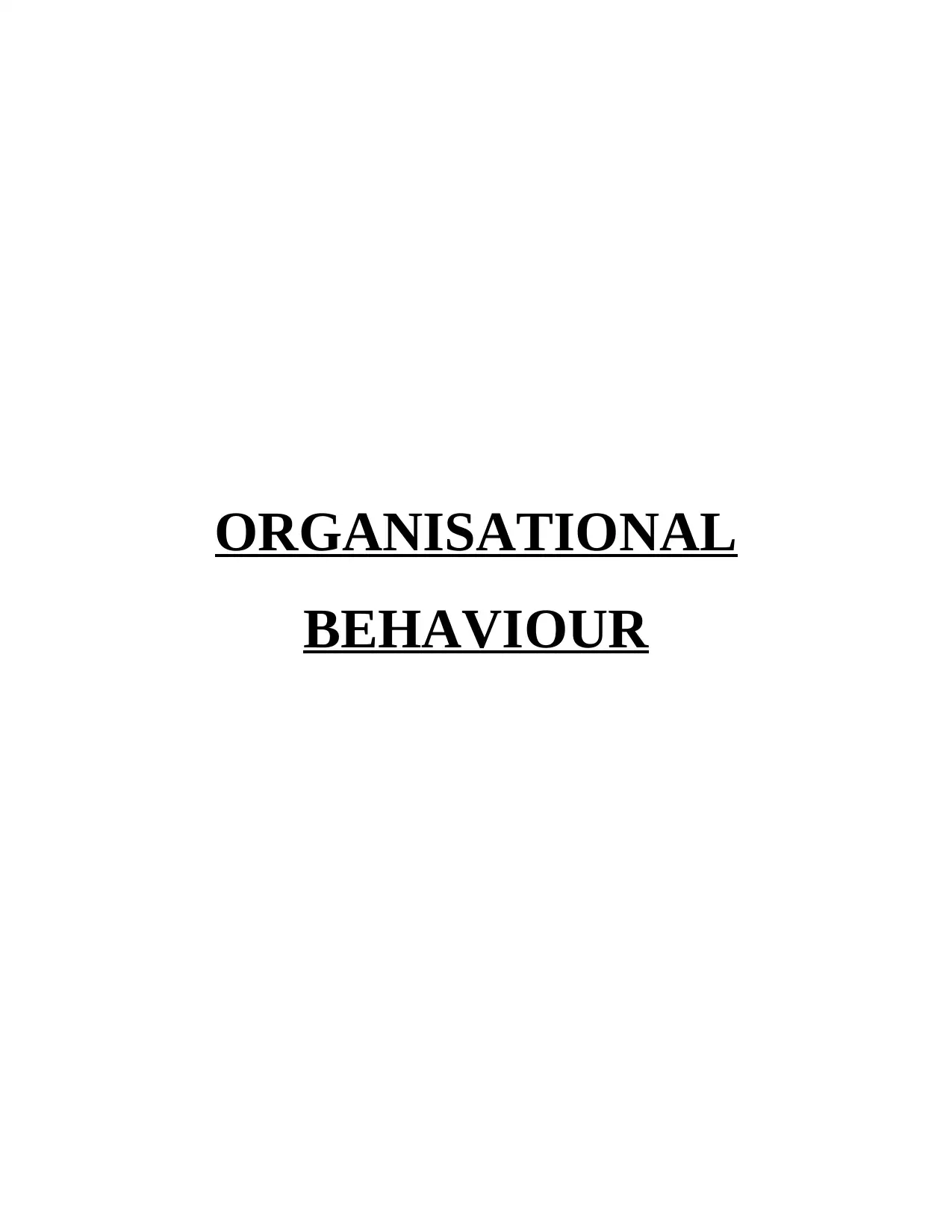
ORGANISATIONAL
BEHAVIOUR
BEHAVIOUR
Paraphrase This Document
Need a fresh take? Get an instant paraphrase of this document with our AI Paraphraser
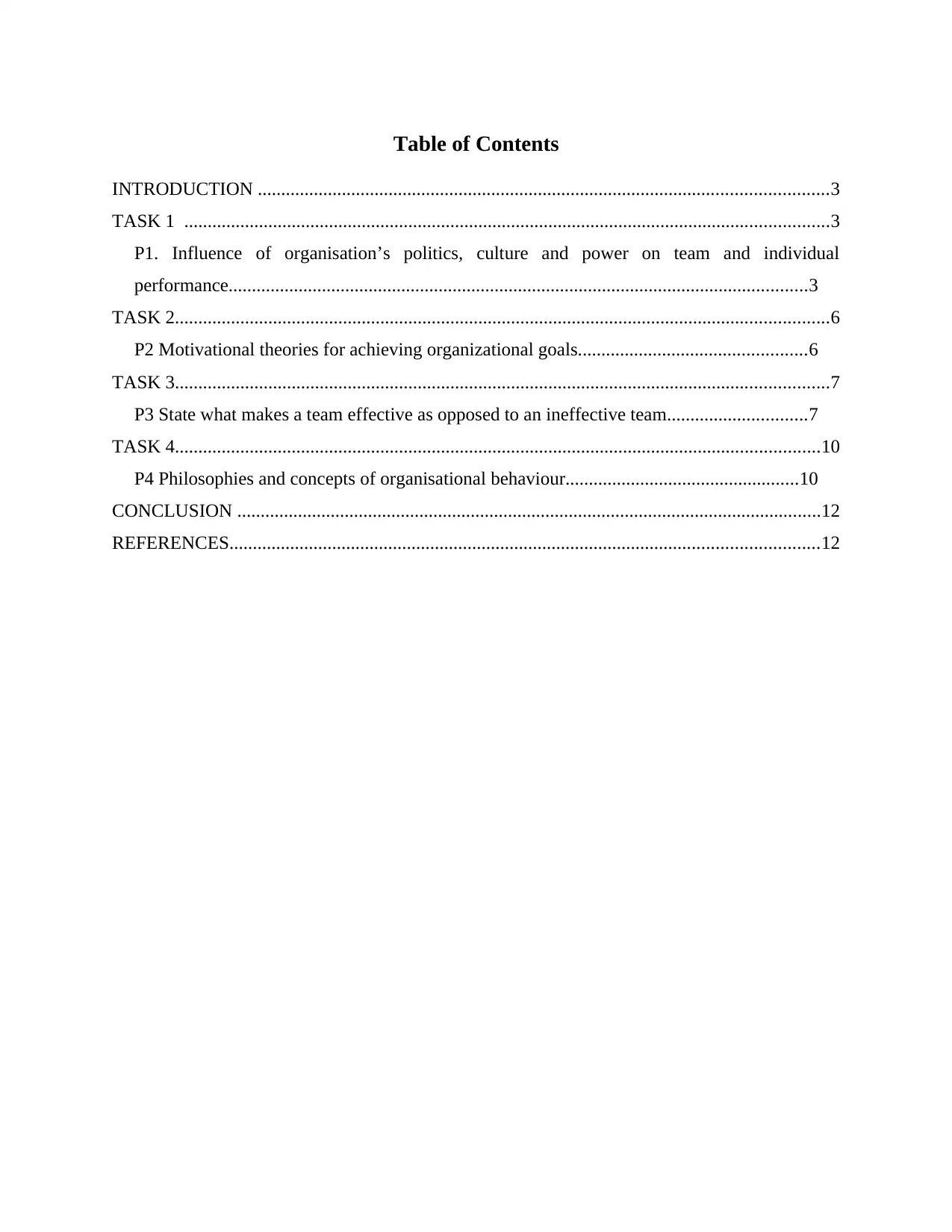
Table of Contents
INTRODUCTION ..........................................................................................................................3
TASK 1 ..........................................................................................................................................3
P1. Influence of organisation’s politics, culture and power on team and individual
performance............................................................................................................................3
TASK 2............................................................................................................................................6
P2 Motivational theories for achieving organizational goals.................................................6
TASK 3............................................................................................................................................7
P3 State what makes a team effective as opposed to an ineffective team..............................7
TASK 4..........................................................................................................................................10
P4 Philosophies and concepts of organisational behaviour..................................................10
CONCLUSION .............................................................................................................................12
REFERENCES..............................................................................................................................12
INTRODUCTION ..........................................................................................................................3
TASK 1 ..........................................................................................................................................3
P1. Influence of organisation’s politics, culture and power on team and individual
performance............................................................................................................................3
TASK 2............................................................................................................................................6
P2 Motivational theories for achieving organizational goals.................................................6
TASK 3............................................................................................................................................7
P3 State what makes a team effective as opposed to an ineffective team..............................7
TASK 4..........................................................................................................................................10
P4 Philosophies and concepts of organisational behaviour..................................................10
CONCLUSION .............................................................................................................................12
REFERENCES..............................................................................................................................12
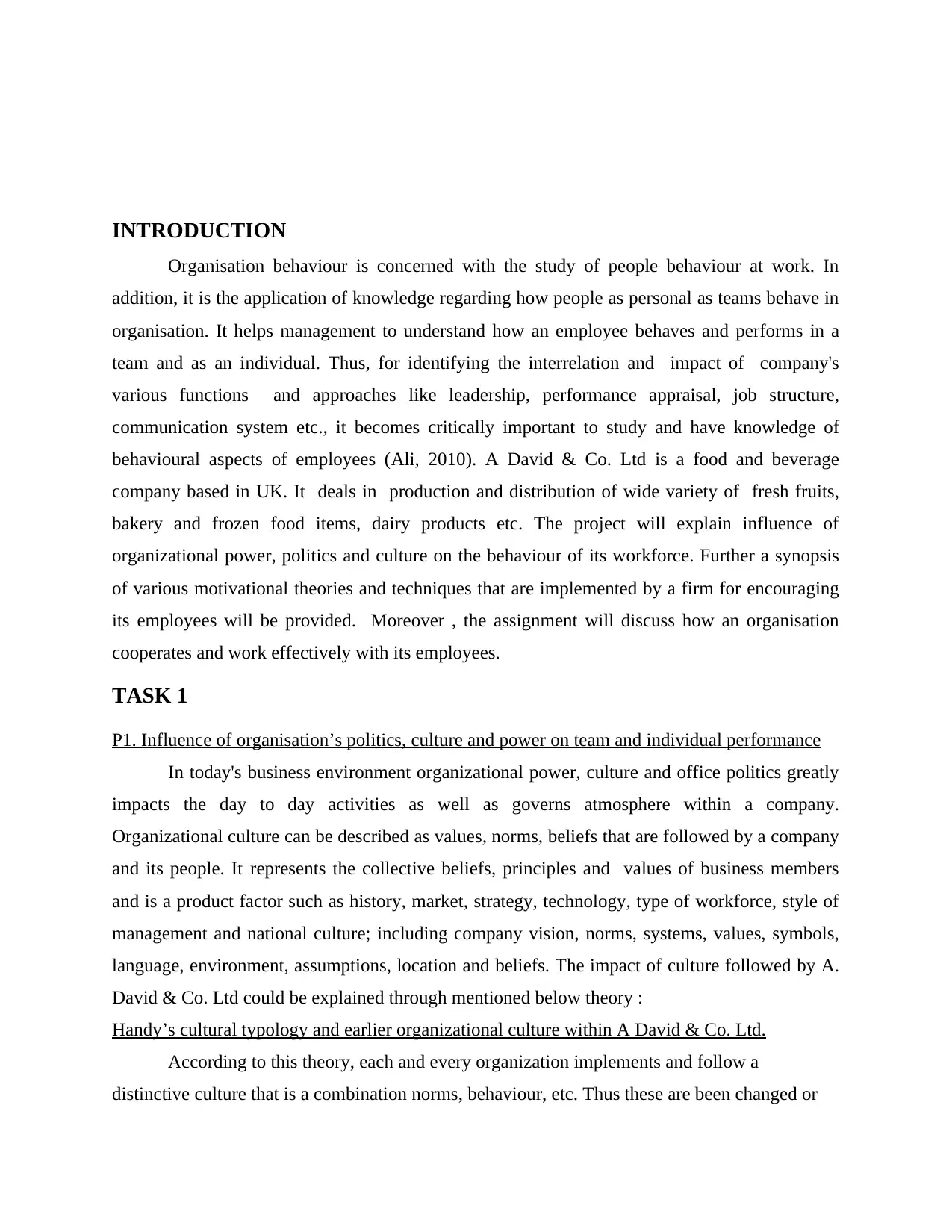
INTRODUCTION
Organisation behaviour is concerned with the study of people behaviour at work. In
addition, it is the application of knowledge regarding how people as personal as teams behave in
organisation. It helps management to understand how an employee behaves and performs in a
team and as an individual. Thus, for identifying the interrelation and impact of company's
various functions and approaches like leadership, performance appraisal, job structure,
communication system etc., it becomes critically important to study and have knowledge of
behavioural aspects of employees (Ali, 2010). A David & Co. Ltd is a food and beverage
company based in UK. It deals in production and distribution of wide variety of fresh fruits,
bakery and frozen food items, dairy products etc. The project will explain influence of
organizational power, politics and culture on the behaviour of its workforce. Further a synopsis
of various motivational theories and techniques that are implemented by a firm for encouraging
its employees will be provided. Moreover , the assignment will discuss how an organisation
cooperates and work effectively with its employees.
TASK 1
P1. Influence of organisation’s politics, culture and power on team and individual performance
In today's business environment organizational power, culture and office politics greatly
impacts the day to day activities as well as governs atmosphere within a company.
Organizational culture can be described as values, norms, beliefs that are followed by a company
and its people. It represents the collective beliefs, principles and values of business members
and is a product factor such as history, market, strategy, technology, type of workforce, style of
management and national culture; including company vision, norms, systems, values, symbols,
language, environment, assumptions, location and beliefs. The impact of culture followed by A.
David & Co. Ltd could be explained through mentioned below theory :
Handy’s cultural typology and earlier organizational culture within A David & Co. Ltd.
According to this theory, each and every organization implements and follow a
distinctive culture that is a combination norms, behaviour, etc. Thus these are been changed or
Organisation behaviour is concerned with the study of people behaviour at work. In
addition, it is the application of knowledge regarding how people as personal as teams behave in
organisation. It helps management to understand how an employee behaves and performs in a
team and as an individual. Thus, for identifying the interrelation and impact of company's
various functions and approaches like leadership, performance appraisal, job structure,
communication system etc., it becomes critically important to study and have knowledge of
behavioural aspects of employees (Ali, 2010). A David & Co. Ltd is a food and beverage
company based in UK. It deals in production and distribution of wide variety of fresh fruits,
bakery and frozen food items, dairy products etc. The project will explain influence of
organizational power, politics and culture on the behaviour of its workforce. Further a synopsis
of various motivational theories and techniques that are implemented by a firm for encouraging
its employees will be provided. Moreover , the assignment will discuss how an organisation
cooperates and work effectively with its employees.
TASK 1
P1. Influence of organisation’s politics, culture and power on team and individual performance
In today's business environment organizational power, culture and office politics greatly
impacts the day to day activities as well as governs atmosphere within a company.
Organizational culture can be described as values, norms, beliefs that are followed by a company
and its people. It represents the collective beliefs, principles and values of business members
and is a product factor such as history, market, strategy, technology, type of workforce, style of
management and national culture; including company vision, norms, systems, values, symbols,
language, environment, assumptions, location and beliefs. The impact of culture followed by A.
David & Co. Ltd could be explained through mentioned below theory :
Handy’s cultural typology and earlier organizational culture within A David & Co. Ltd.
According to this theory, each and every organization implements and follow a
distinctive culture that is a combination norms, behaviour, etc. Thus these are been changed or
⊘ This is a preview!⊘
Do you want full access?
Subscribe today to unlock all pages.

Trusted by 1+ million students worldwide
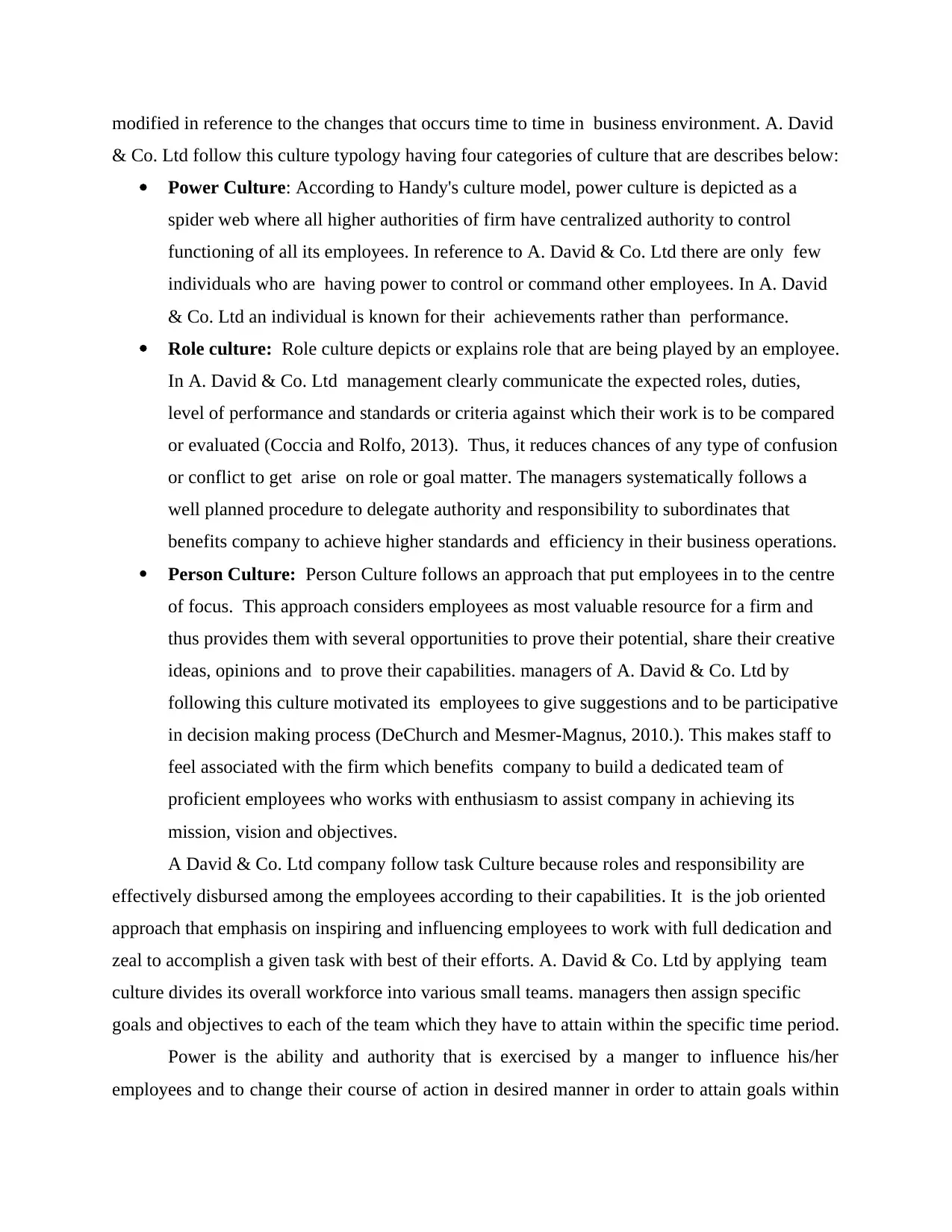
modified in reference to the changes that occurs time to time in business environment. A. David
& Co. Ltd follow this culture typology having four categories of culture that are describes below:
Power Culture: According to Handy's culture model, power culture is depicted as a
spider web where all higher authorities of firm have centralized authority to control
functioning of all its employees. In reference to A. David & Co. Ltd there are only few
individuals who are having power to control or command other employees. In A. David
& Co. Ltd an individual is known for their achievements rather than performance.
Role culture: Role culture depicts or explains role that are being played by an employee.
In A. David & Co. Ltd management clearly communicate the expected roles, duties,
level of performance and standards or criteria against which their work is to be compared
or evaluated (Coccia and Rolfo, 2013). Thus, it reduces chances of any type of confusion
or conflict to get arise on role or goal matter. The managers systematically follows a
well planned procedure to delegate authority and responsibility to subordinates that
benefits company to achieve higher standards and efficiency in their business operations.
Person Culture: Person Culture follows an approach that put employees in to the centre
of focus. This approach considers employees as most valuable resource for a firm and
thus provides them with several opportunities to prove their potential, share their creative
ideas, opinions and to prove their capabilities. managers of A. David & Co. Ltd by
following this culture motivated its employees to give suggestions and to be participative
in decision making process (DeChurch and Mesmer-Magnus, 2010.). This makes staff to
feel associated with the firm which benefits company to build a dedicated team of
proficient employees who works with enthusiasm to assist company in achieving its
mission, vision and objectives.
A David & Co. Ltd company follow task Culture because roles and responsibility are
effectively disbursed among the employees according to their capabilities. It is the job oriented
approach that emphasis on inspiring and influencing employees to work with full dedication and
zeal to accomplish a given task with best of their efforts. A. David & Co. Ltd by applying team
culture divides its overall workforce into various small teams. managers then assign specific
goals and objectives to each of the team which they have to attain within the specific time period.
Power is the ability and authority that is exercised by a manger to influence his/her
employees and to change their course of action in desired manner in order to attain goals within
& Co. Ltd follow this culture typology having four categories of culture that are describes below:
Power Culture: According to Handy's culture model, power culture is depicted as a
spider web where all higher authorities of firm have centralized authority to control
functioning of all its employees. In reference to A. David & Co. Ltd there are only few
individuals who are having power to control or command other employees. In A. David
& Co. Ltd an individual is known for their achievements rather than performance.
Role culture: Role culture depicts or explains role that are being played by an employee.
In A. David & Co. Ltd management clearly communicate the expected roles, duties,
level of performance and standards or criteria against which their work is to be compared
or evaluated (Coccia and Rolfo, 2013). Thus, it reduces chances of any type of confusion
or conflict to get arise on role or goal matter. The managers systematically follows a
well planned procedure to delegate authority and responsibility to subordinates that
benefits company to achieve higher standards and efficiency in their business operations.
Person Culture: Person Culture follows an approach that put employees in to the centre
of focus. This approach considers employees as most valuable resource for a firm and
thus provides them with several opportunities to prove their potential, share their creative
ideas, opinions and to prove their capabilities. managers of A. David & Co. Ltd by
following this culture motivated its employees to give suggestions and to be participative
in decision making process (DeChurch and Mesmer-Magnus, 2010.). This makes staff to
feel associated with the firm which benefits company to build a dedicated team of
proficient employees who works with enthusiasm to assist company in achieving its
mission, vision and objectives.
A David & Co. Ltd company follow task Culture because roles and responsibility are
effectively disbursed among the employees according to their capabilities. It is the job oriented
approach that emphasis on inspiring and influencing employees to work with full dedication and
zeal to accomplish a given task with best of their efforts. A. David & Co. Ltd by applying team
culture divides its overall workforce into various small teams. managers then assign specific
goals and objectives to each of the team which they have to attain within the specific time period.
Power is the ability and authority that is exercised by a manger to influence his/her
employees and to change their course of action in desired manner in order to attain goals within
Paraphrase This Document
Need a fresh take? Get an instant paraphrase of this document with our AI Paraphraser
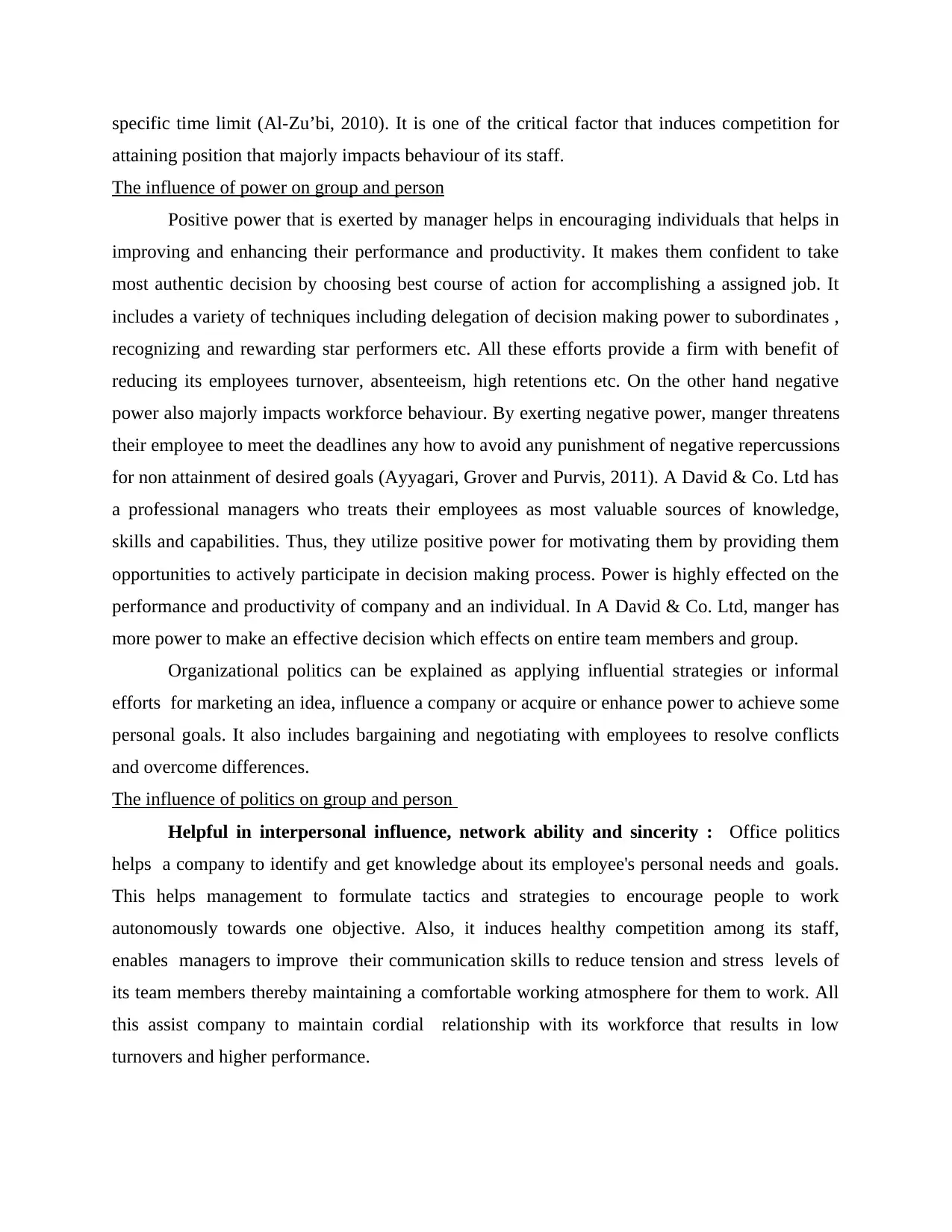
specific time limit (Al-Zu’bi, 2010). It is one of the critical factor that induces competition for
attaining position that majorly impacts behaviour of its staff.
The influence of power on group and person
Positive power that is exerted by manager helps in encouraging individuals that helps in
improving and enhancing their performance and productivity. It makes them confident to take
most authentic decision by choosing best course of action for accomplishing a assigned job. It
includes a variety of techniques including delegation of decision making power to subordinates ,
recognizing and rewarding star performers etc. All these efforts provide a firm with benefit of
reducing its employees turnover, absenteeism, high retentions etc. On the other hand negative
power also majorly impacts workforce behaviour. By exerting negative power, manger threatens
their employee to meet the deadlines any how to avoid any punishment of negative repercussions
for non attainment of desired goals (Ayyagari, Grover and Purvis, 2011). A David & Co. Ltd has
a professional managers who treats their employees as most valuable sources of knowledge,
skills and capabilities. Thus, they utilize positive power for motivating them by providing them
opportunities to actively participate in decision making process. Power is highly effected on the
performance and productivity of company and an individual. In A David & Co. Ltd, manger has
more power to make an effective decision which effects on entire team members and group.
Organizational politics can be explained as applying influential strategies or informal
efforts for marketing an idea, influence a company or acquire or enhance power to achieve some
personal goals. It also includes bargaining and negotiating with employees to resolve conflicts
and overcome differences.
The influence of politics on group and person
Helpful in interpersonal influence, network ability and sincerity : Office politics
helps a company to identify and get knowledge about its employee's personal needs and goals.
This helps management to formulate tactics and strategies to encourage people to work
autonomously towards one objective. Also, it induces healthy competition among its staff,
enables managers to improve their communication skills to reduce tension and stress levels of
its team members thereby maintaining a comfortable working atmosphere for them to work. All
this assist company to maintain cordial relationship with its workforce that results in low
turnovers and higher performance.
attaining position that majorly impacts behaviour of its staff.
The influence of power on group and person
Positive power that is exerted by manager helps in encouraging individuals that helps in
improving and enhancing their performance and productivity. It makes them confident to take
most authentic decision by choosing best course of action for accomplishing a assigned job. It
includes a variety of techniques including delegation of decision making power to subordinates ,
recognizing and rewarding star performers etc. All these efforts provide a firm with benefit of
reducing its employees turnover, absenteeism, high retentions etc. On the other hand negative
power also majorly impacts workforce behaviour. By exerting negative power, manger threatens
their employee to meet the deadlines any how to avoid any punishment of negative repercussions
for non attainment of desired goals (Ayyagari, Grover and Purvis, 2011). A David & Co. Ltd has
a professional managers who treats their employees as most valuable sources of knowledge,
skills and capabilities. Thus, they utilize positive power for motivating them by providing them
opportunities to actively participate in decision making process. Power is highly effected on the
performance and productivity of company and an individual. In A David & Co. Ltd, manger has
more power to make an effective decision which effects on entire team members and group.
Organizational politics can be explained as applying influential strategies or informal
efforts for marketing an idea, influence a company or acquire or enhance power to achieve some
personal goals. It also includes bargaining and negotiating with employees to resolve conflicts
and overcome differences.
The influence of politics on group and person
Helpful in interpersonal influence, network ability and sincerity : Office politics
helps a company to identify and get knowledge about its employee's personal needs and goals.
This helps management to formulate tactics and strategies to encourage people to work
autonomously towards one objective. Also, it induces healthy competition among its staff,
enables managers to improve their communication skills to reduce tension and stress levels of
its team members thereby maintaining a comfortable working atmosphere for them to work. All
this assist company to maintain cordial relationship with its workforce that results in low
turnovers and higher performance.
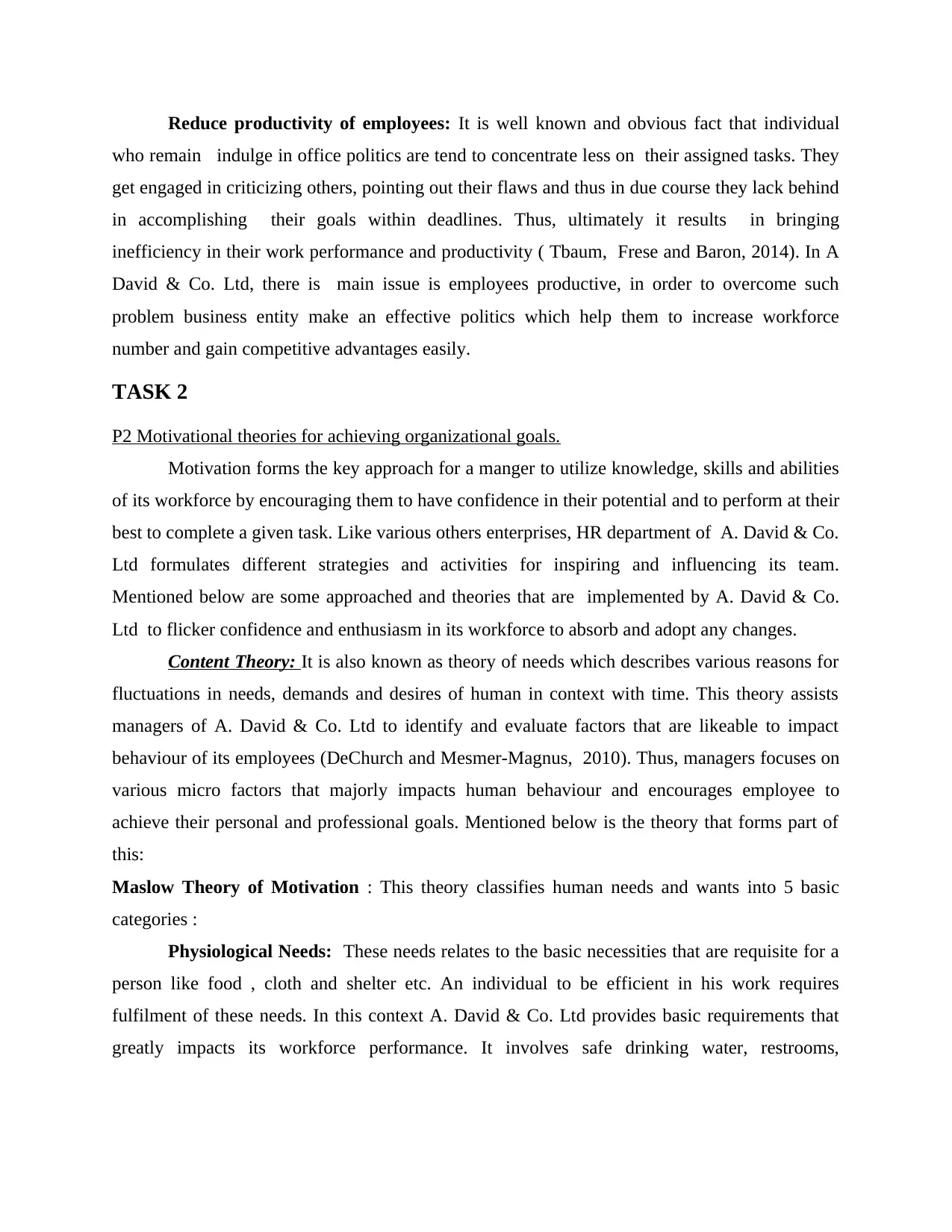
Reduce productivity of employees: It is well known and obvious fact that individual
who remain indulge in office politics are tend to concentrate less on their assigned tasks. They
get engaged in criticizing others, pointing out their flaws and thus in due course they lack behind
in accomplishing their goals within deadlines. Thus, ultimately it results in bringing
inefficiency in their work performance and productivity ( Tbaum, Frese and Baron, 2014). In A
David & Co. Ltd, there is main issue is employees productive, in order to overcome such
problem business entity make an effective politics which help them to increase workforce
number and gain competitive advantages easily.
TASK 2
P2 Motivational theories for achieving organizational goals.
Motivation forms the key approach for a manger to utilize knowledge, skills and abilities
of its workforce by encouraging them to have confidence in their potential and to perform at their
best to complete a given task. Like various others enterprises, HR department of A. David & Co.
Ltd formulates different strategies and activities for inspiring and influencing its team.
Mentioned below are some approached and theories that are implemented by A. David & Co.
Ltd to flicker confidence and enthusiasm in its workforce to absorb and adopt any changes.
Content Theory: It is also known as theory of needs which describes various reasons for
fluctuations in needs, demands and desires of human in context with time. This theory assists
managers of A. David & Co. Ltd to identify and evaluate factors that are likeable to impact
behaviour of its employees (DeChurch and Mesmer-Magnus, 2010). Thus, managers focuses on
various micro factors that majorly impacts human behaviour and encourages employee to
achieve their personal and professional goals. Mentioned below is the theory that forms part of
this:
Maslow Theory of Motivation : This theory classifies human needs and wants into 5 basic
categories :
Physiological Needs: These needs relates to the basic necessities that are requisite for a
person like food , cloth and shelter etc. An individual to be efficient in his work requires
fulfilment of these needs. In this context A. David & Co. Ltd provides basic requirements that
greatly impacts its workforce performance. It involves safe drinking water, restrooms,
who remain indulge in office politics are tend to concentrate less on their assigned tasks. They
get engaged in criticizing others, pointing out their flaws and thus in due course they lack behind
in accomplishing their goals within deadlines. Thus, ultimately it results in bringing
inefficiency in their work performance and productivity ( Tbaum, Frese and Baron, 2014). In A
David & Co. Ltd, there is main issue is employees productive, in order to overcome such
problem business entity make an effective politics which help them to increase workforce
number and gain competitive advantages easily.
TASK 2
P2 Motivational theories for achieving organizational goals.
Motivation forms the key approach for a manger to utilize knowledge, skills and abilities
of its workforce by encouraging them to have confidence in their potential and to perform at their
best to complete a given task. Like various others enterprises, HR department of A. David & Co.
Ltd formulates different strategies and activities for inspiring and influencing its team.
Mentioned below are some approached and theories that are implemented by A. David & Co.
Ltd to flicker confidence and enthusiasm in its workforce to absorb and adopt any changes.
Content Theory: It is also known as theory of needs which describes various reasons for
fluctuations in needs, demands and desires of human in context with time. This theory assists
managers of A. David & Co. Ltd to identify and evaluate factors that are likeable to impact
behaviour of its employees (DeChurch and Mesmer-Magnus, 2010). Thus, managers focuses on
various micro factors that majorly impacts human behaviour and encourages employee to
achieve their personal and professional goals. Mentioned below is the theory that forms part of
this:
Maslow Theory of Motivation : This theory classifies human needs and wants into 5 basic
categories :
Physiological Needs: These needs relates to the basic necessities that are requisite for a
person like food , cloth and shelter etc. An individual to be efficient in his work requires
fulfilment of these needs. In this context A. David & Co. Ltd provides basic requirements that
greatly impacts its workforce performance. It involves safe drinking water, restrooms,
⊘ This is a preview!⊘
Do you want full access?
Subscribe today to unlock all pages.

Trusted by 1+ million students worldwide
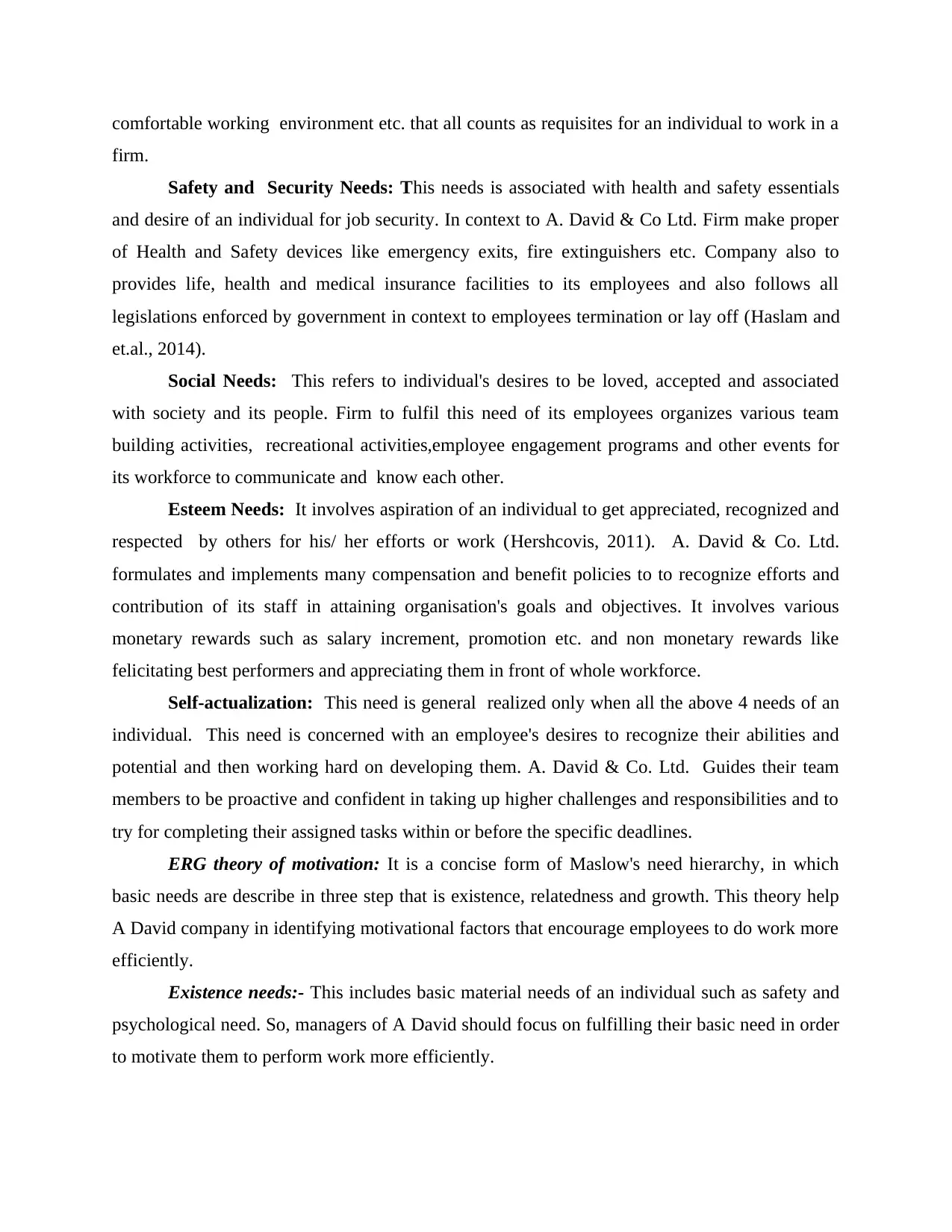
comfortable working environment etc. that all counts as requisites for an individual to work in a
firm.
Safety and Security Needs: This needs is associated with health and safety essentials
and desire of an individual for job security. In context to A. David & Co Ltd. Firm make proper
of Health and Safety devices like emergency exits, fire extinguishers etc. Company also to
provides life, health and medical insurance facilities to its employees and also follows all
legislations enforced by government in context to employees termination or lay off (Haslam and
et.al., 2014).
Social Needs: This refers to individual's desires to be loved, accepted and associated
with society and its people. Firm to fulfil this need of its employees organizes various team
building activities, recreational activities,employee engagement programs and other events for
its workforce to communicate and know each other.
Esteem Needs: It involves aspiration of an individual to get appreciated, recognized and
respected by others for his/ her efforts or work (Hershcovis, 2011). A. David & Co. Ltd.
formulates and implements many compensation and benefit policies to to recognize efforts and
contribution of its staff in attaining organisation's goals and objectives. It involves various
monetary rewards such as salary increment, promotion etc. and non monetary rewards like
felicitating best performers and appreciating them in front of whole workforce.
Self-actualization: This need is general realized only when all the above 4 needs of an
individual. This need is concerned with an employee's desires to recognize their abilities and
potential and then working hard on developing them. A. David & Co. Ltd. Guides their team
members to be proactive and confident in taking up higher challenges and responsibilities and to
try for completing their assigned tasks within or before the specific deadlines.
ERG theory of motivation: It is a concise form of Maslow's need hierarchy, in which
basic needs are describe in three step that is existence, relatedness and growth. This theory help
A David company in identifying motivational factors that encourage employees to do work more
efficiently.
Existence needs:- This includes basic material needs of an individual such as safety and
psychological need. So, managers of A David should focus on fulfilling their basic need in order
to motivate them to perform work more efficiently.
firm.
Safety and Security Needs: This needs is associated with health and safety essentials
and desire of an individual for job security. In context to A. David & Co Ltd. Firm make proper
of Health and Safety devices like emergency exits, fire extinguishers etc. Company also to
provides life, health and medical insurance facilities to its employees and also follows all
legislations enforced by government in context to employees termination or lay off (Haslam and
et.al., 2014).
Social Needs: This refers to individual's desires to be loved, accepted and associated
with society and its people. Firm to fulfil this need of its employees organizes various team
building activities, recreational activities,employee engagement programs and other events for
its workforce to communicate and know each other.
Esteem Needs: It involves aspiration of an individual to get appreciated, recognized and
respected by others for his/ her efforts or work (Hershcovis, 2011). A. David & Co. Ltd.
formulates and implements many compensation and benefit policies to to recognize efforts and
contribution of its staff in attaining organisation's goals and objectives. It involves various
monetary rewards such as salary increment, promotion etc. and non monetary rewards like
felicitating best performers and appreciating them in front of whole workforce.
Self-actualization: This need is general realized only when all the above 4 needs of an
individual. This need is concerned with an employee's desires to recognize their abilities and
potential and then working hard on developing them. A. David & Co. Ltd. Guides their team
members to be proactive and confident in taking up higher challenges and responsibilities and to
try for completing their assigned tasks within or before the specific deadlines.
ERG theory of motivation: It is a concise form of Maslow's need hierarchy, in which
basic needs are describe in three step that is existence, relatedness and growth. This theory help
A David company in identifying motivational factors that encourage employees to do work more
efficiently.
Existence needs:- This includes basic material needs of an individual such as safety and
psychological need. So, managers of A David should focus on fulfilling their basic need in order
to motivate them to perform work more efficiently.
Paraphrase This Document
Need a fresh take? Get an instant paraphrase of this document with our AI Paraphraser
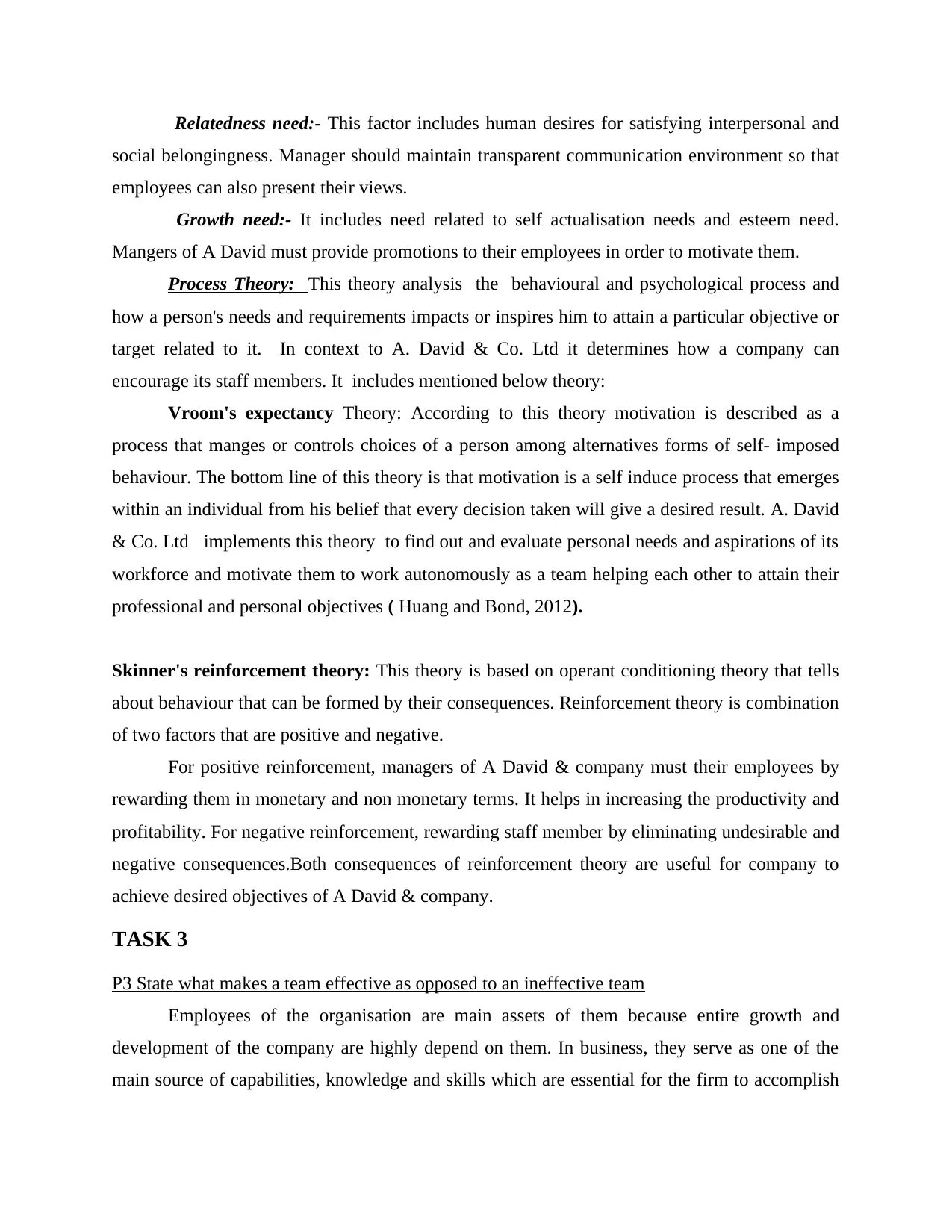
Relatedness need:- This factor includes human desires for satisfying interpersonal and
social belongingness. Manager should maintain transparent communication environment so that
employees can also present their views.
Growth need:- It includes need related to self actualisation needs and esteem need.
Mangers of A David must provide promotions to their employees in order to motivate them.
Process Theory: This theory analysis the behavioural and psychological process and
how a person's needs and requirements impacts or inspires him to attain a particular objective or
target related to it. In context to A. David & Co. Ltd it determines how a company can
encourage its staff members. It includes mentioned below theory:
Vroom's expectancy Theory: According to this theory motivation is described as a
process that manges or controls choices of a person among alternatives forms of self- imposed
behaviour. The bottom line of this theory is that motivation is a self induce process that emerges
within an individual from his belief that every decision taken will give a desired result. A. David
& Co. Ltd implements this theory to find out and evaluate personal needs and aspirations of its
workforce and motivate them to work autonomously as a team helping each other to attain their
professional and personal objectives ( Huang and Bond, 2012).
Skinner's reinforcement theory: This theory is based on operant conditioning theory that tells
about behaviour that can be formed by their consequences. Reinforcement theory is combination
of two factors that are positive and negative.
For positive reinforcement, managers of A David & company must their employees by
rewarding them in monetary and non monetary terms. It helps in increasing the productivity and
profitability. For negative reinforcement, rewarding staff member by eliminating undesirable and
negative consequences.Both consequences of reinforcement theory are useful for company to
achieve desired objectives of A David & company.
TASK 3
P3 State what makes a team effective as opposed to an ineffective team
Employees of the organisation are main assets of them because entire growth and
development of the company are highly depend on them. In business, they serve as one of the
main source of capabilities, knowledge and skills which are essential for the firm to accomplish
social belongingness. Manager should maintain transparent communication environment so that
employees can also present their views.
Growth need:- It includes need related to self actualisation needs and esteem need.
Mangers of A David must provide promotions to their employees in order to motivate them.
Process Theory: This theory analysis the behavioural and psychological process and
how a person's needs and requirements impacts or inspires him to attain a particular objective or
target related to it. In context to A. David & Co. Ltd it determines how a company can
encourage its staff members. It includes mentioned below theory:
Vroom's expectancy Theory: According to this theory motivation is described as a
process that manges or controls choices of a person among alternatives forms of self- imposed
behaviour. The bottom line of this theory is that motivation is a self induce process that emerges
within an individual from his belief that every decision taken will give a desired result. A. David
& Co. Ltd implements this theory to find out and evaluate personal needs and aspirations of its
workforce and motivate them to work autonomously as a team helping each other to attain their
professional and personal objectives ( Huang and Bond, 2012).
Skinner's reinforcement theory: This theory is based on operant conditioning theory that tells
about behaviour that can be formed by their consequences. Reinforcement theory is combination
of two factors that are positive and negative.
For positive reinforcement, managers of A David & company must their employees by
rewarding them in monetary and non monetary terms. It helps in increasing the productivity and
profitability. For negative reinforcement, rewarding staff member by eliminating undesirable and
negative consequences.Both consequences of reinforcement theory are useful for company to
achieve desired objectives of A David & company.
TASK 3
P3 State what makes a team effective as opposed to an ineffective team
Employees of the organisation are main assets of them because entire growth and
development of the company are highly depend on them. In business, they serve as one of the
main source of capabilities, knowledge and skills which are essential for the firm to accomplish
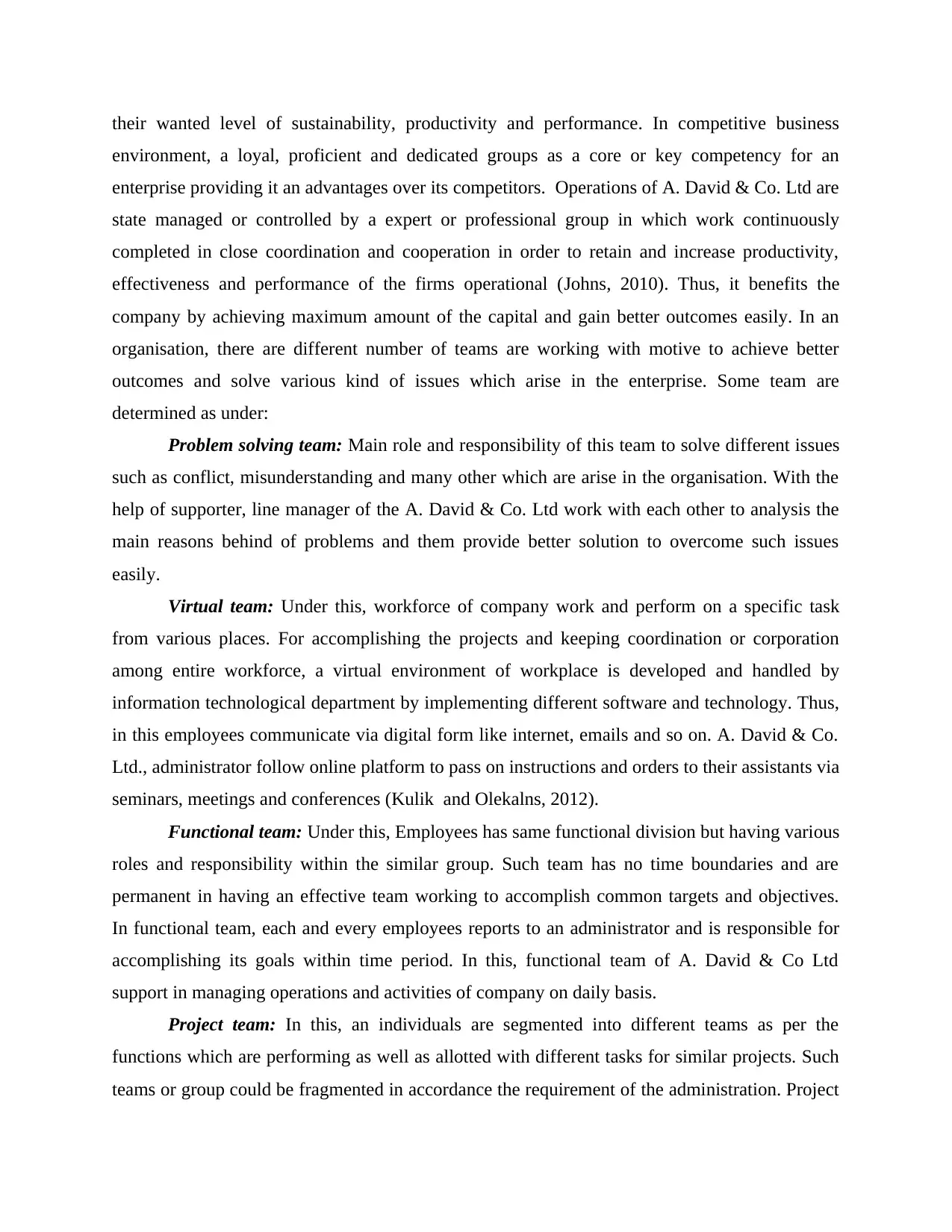
their wanted level of sustainability, productivity and performance. In competitive business
environment, a loyal, proficient and dedicated groups as a core or key competency for an
enterprise providing it an advantages over its competitors. Operations of A. David & Co. Ltd are
state managed or controlled by a expert or professional group in which work continuously
completed in close coordination and cooperation in order to retain and increase productivity,
effectiveness and performance of the firms operational (Johns, 2010). Thus, it benefits the
company by achieving maximum amount of the capital and gain better outcomes easily. In an
organisation, there are different number of teams are working with motive to achieve better
outcomes and solve various kind of issues which arise in the enterprise. Some team are
determined as under:
Problem solving team: Main role and responsibility of this team to solve different issues
such as conflict, misunderstanding and many other which are arise in the organisation. With the
help of supporter, line manager of the A. David & Co. Ltd work with each other to analysis the
main reasons behind of problems and them provide better solution to overcome such issues
easily.
Virtual team: Under this, workforce of company work and perform on a specific task
from various places. For accomplishing the projects and keeping coordination or corporation
among entire workforce, a virtual environment of workplace is developed and handled by
information technological department by implementing different software and technology. Thus,
in this employees communicate via digital form like internet, emails and so on. A. David & Co.
Ltd., administrator follow online platform to pass on instructions and orders to their assistants via
seminars, meetings and conferences (Kulik and Olekalns, 2012).
Functional team: Under this, Employees has same functional division but having various
roles and responsibility within the similar group. Such team has no time boundaries and are
permanent in having an effective team working to accomplish common targets and objectives.
In functional team, each and every employees reports to an administrator and is responsible for
accomplishing its goals within time period. In this, functional team of A. David & Co Ltd
support in managing operations and activities of company on daily basis.
Project team: In this, an individuals are segmented into different teams as per the
functions which are performing as well as allotted with different tasks for similar projects. Such
teams or group could be fragmented in accordance the requirement of the administration. Project
environment, a loyal, proficient and dedicated groups as a core or key competency for an
enterprise providing it an advantages over its competitors. Operations of A. David & Co. Ltd are
state managed or controlled by a expert or professional group in which work continuously
completed in close coordination and cooperation in order to retain and increase productivity,
effectiveness and performance of the firms operational (Johns, 2010). Thus, it benefits the
company by achieving maximum amount of the capital and gain better outcomes easily. In an
organisation, there are different number of teams are working with motive to achieve better
outcomes and solve various kind of issues which arise in the enterprise. Some team are
determined as under:
Problem solving team: Main role and responsibility of this team to solve different issues
such as conflict, misunderstanding and many other which are arise in the organisation. With the
help of supporter, line manager of the A. David & Co. Ltd work with each other to analysis the
main reasons behind of problems and them provide better solution to overcome such issues
easily.
Virtual team: Under this, workforce of company work and perform on a specific task
from various places. For accomplishing the projects and keeping coordination or corporation
among entire workforce, a virtual environment of workplace is developed and handled by
information technological department by implementing different software and technology. Thus,
in this employees communicate via digital form like internet, emails and so on. A. David & Co.
Ltd., administrator follow online platform to pass on instructions and orders to their assistants via
seminars, meetings and conferences (Kulik and Olekalns, 2012).
Functional team: Under this, Employees has same functional division but having various
roles and responsibility within the similar group. Such team has no time boundaries and are
permanent in having an effective team working to accomplish common targets and objectives.
In functional team, each and every employees reports to an administrator and is responsible for
accomplishing its goals within time period. In this, functional team of A. David & Co Ltd
support in managing operations and activities of company on daily basis.
Project team: In this, an individuals are segmented into different teams as per the
functions which are performing as well as allotted with different tasks for similar projects. Such
teams or group could be fragmented in accordance the requirement of the administration. Project
⊘ This is a preview!⊘
Do you want full access?
Subscribe today to unlock all pages.

Trusted by 1+ million students worldwide
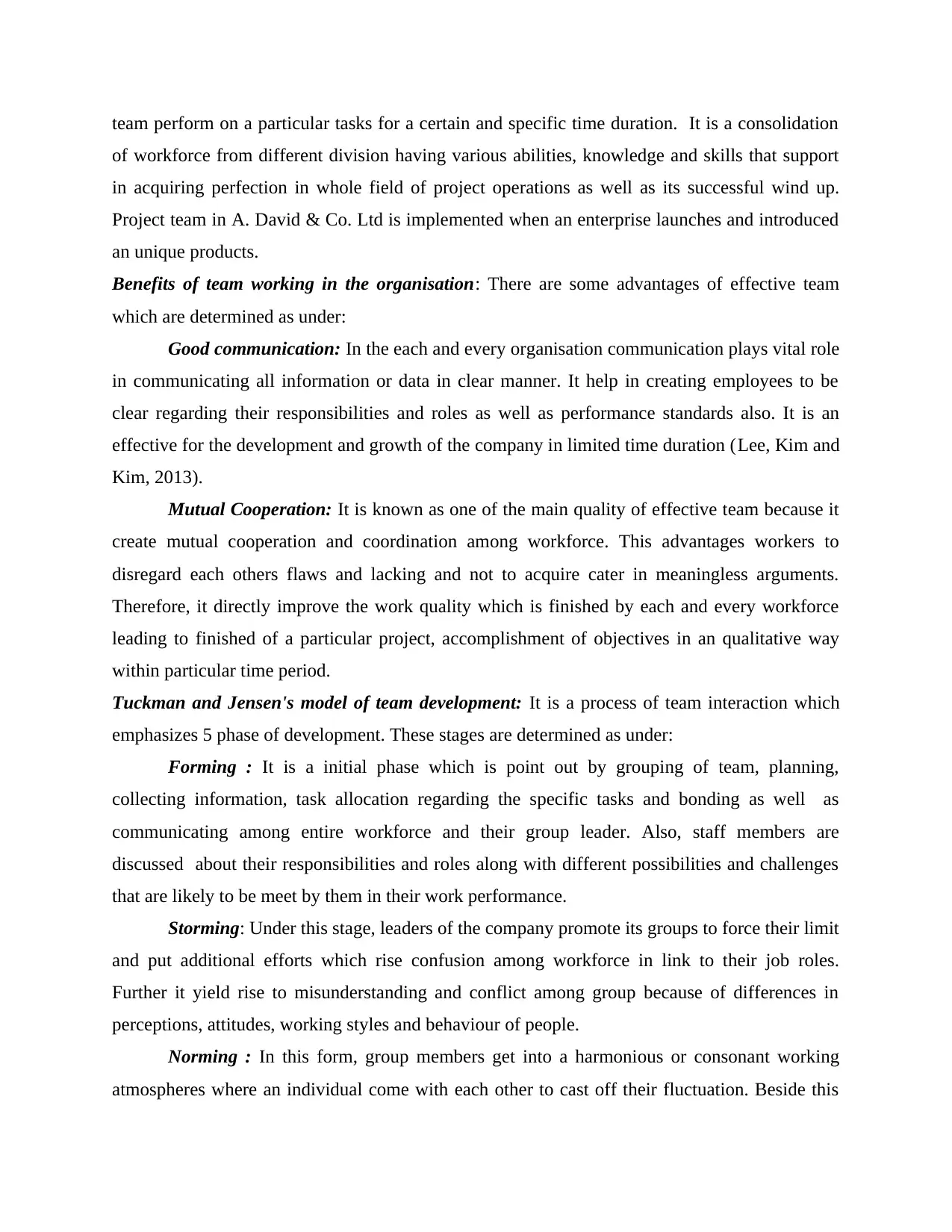
team perform on a particular tasks for a certain and specific time duration. It is a consolidation
of workforce from different division having various abilities, knowledge and skills that support
in acquiring perfection in whole field of project operations as well as its successful wind up.
Project team in A. David & Co. Ltd is implemented when an enterprise launches and introduced
an unique products.
Benefits of team working in the organisation: There are some advantages of effective team
which are determined as under:
Good communication: In the each and every organisation communication plays vital role
in communicating all information or data in clear manner. It help in creating employees to be
clear regarding their responsibilities and roles as well as performance standards also. It is an
effective for the development and growth of the company in limited time duration (Lee, Kim and
Kim, 2013).
Mutual Cooperation: It is known as one of the main quality of effective team because it
create mutual cooperation and coordination among workforce. This advantages workers to
disregard each others flaws and lacking and not to acquire cater in meaningless arguments.
Therefore, it directly improve the work quality which is finished by each and every workforce
leading to finished of a particular project, accomplishment of objectives in an qualitative way
within particular time period.
Tuckman and Jensen's model of team development: It is a process of team interaction which
emphasizes 5 phase of development. These stages are determined as under:
Forming : It is a initial phase which is point out by grouping of team, planning,
collecting information, task allocation regarding the specific tasks and bonding as well as
communicating among entire workforce and their group leader. Also, staff members are
discussed about their responsibilities and roles along with different possibilities and challenges
that are likely to be meet by them in their work performance.
Storming: Under this stage, leaders of the company promote its groups to force their limit
and put additional efforts which rise confusion among workforce in link to their job roles.
Further it yield rise to misunderstanding and conflict among group because of differences in
perceptions, attitudes, working styles and behaviour of people.
Norming : In this form, group members get into a harmonious or consonant working
atmospheres where an individual come with each other to cast off their fluctuation. Beside this
of workforce from different division having various abilities, knowledge and skills that support
in acquiring perfection in whole field of project operations as well as its successful wind up.
Project team in A. David & Co. Ltd is implemented when an enterprise launches and introduced
an unique products.
Benefits of team working in the organisation: There are some advantages of effective team
which are determined as under:
Good communication: In the each and every organisation communication plays vital role
in communicating all information or data in clear manner. It help in creating employees to be
clear regarding their responsibilities and roles as well as performance standards also. It is an
effective for the development and growth of the company in limited time duration (Lee, Kim and
Kim, 2013).
Mutual Cooperation: It is known as one of the main quality of effective team because it
create mutual cooperation and coordination among workforce. This advantages workers to
disregard each others flaws and lacking and not to acquire cater in meaningless arguments.
Therefore, it directly improve the work quality which is finished by each and every workforce
leading to finished of a particular project, accomplishment of objectives in an qualitative way
within particular time period.
Tuckman and Jensen's model of team development: It is a process of team interaction which
emphasizes 5 phase of development. These stages are determined as under:
Forming : It is a initial phase which is point out by grouping of team, planning,
collecting information, task allocation regarding the specific tasks and bonding as well as
communicating among entire workforce and their group leader. Also, staff members are
discussed about their responsibilities and roles along with different possibilities and challenges
that are likely to be meet by them in their work performance.
Storming: Under this stage, leaders of the company promote its groups to force their limit
and put additional efforts which rise confusion among workforce in link to their job roles.
Further it yield rise to misunderstanding and conflict among group because of differences in
perceptions, attitudes, working styles and behaviour of people.
Norming : In this form, group members get into a harmonious or consonant working
atmospheres where an individual come with each other to cast off their fluctuation. Beside this
Paraphrase This Document
Need a fresh take? Get an instant paraphrase of this document with our AI Paraphraser
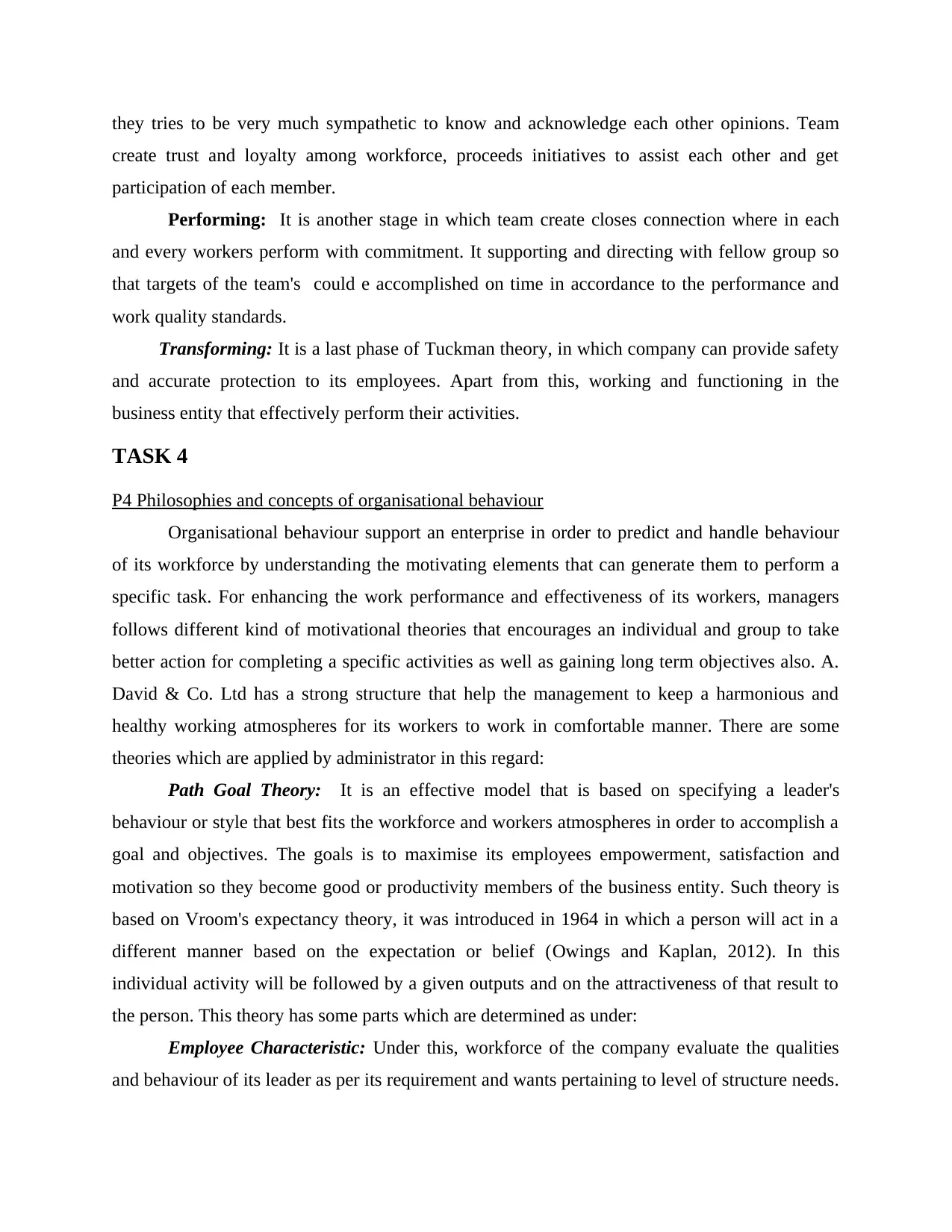
they tries to be very much sympathetic to know and acknowledge each other opinions. Team
create trust and loyalty among workforce, proceeds initiatives to assist each other and get
participation of each member.
Performing: It is another stage in which team create closes connection where in each
and every workers perform with commitment. It supporting and directing with fellow group so
that targets of the team's could e accomplished on time in accordance to the performance and
work quality standards.
Transforming: It is a last phase of Tuckman theory, in which company can provide safety
and accurate protection to its employees. Apart from this, working and functioning in the
business entity that effectively perform their activities.
TASK 4
P4 Philosophies and concepts of organisational behaviour
Organisational behaviour support an enterprise in order to predict and handle behaviour
of its workforce by understanding the motivating elements that can generate them to perform a
specific task. For enhancing the work performance and effectiveness of its workers, managers
follows different kind of motivational theories that encourages an individual and group to take
better action for completing a specific activities as well as gaining long term objectives also. A.
David & Co. Ltd has a strong structure that help the management to keep a harmonious and
healthy working atmospheres for its workers to work in comfortable manner. There are some
theories which are applied by administrator in this regard:
Path Goal Theory: It is an effective model that is based on specifying a leader's
behaviour or style that best fits the workforce and workers atmospheres in order to accomplish a
goal and objectives. The goals is to maximise its employees empowerment, satisfaction and
motivation so they become good or productivity members of the business entity. Such theory is
based on Vroom's expectancy theory, it was introduced in 1964 in which a person will act in a
different manner based on the expectation or belief (Owings and Kaplan, 2012). In this
individual activity will be followed by a given outputs and on the attractiveness of that result to
the person. This theory has some parts which are determined as under:
Employee Characteristic: Under this, workforce of the company evaluate the qualities
and behaviour of its leader as per its requirement and wants pertaining to level of structure needs.
create trust and loyalty among workforce, proceeds initiatives to assist each other and get
participation of each member.
Performing: It is another stage in which team create closes connection where in each
and every workers perform with commitment. It supporting and directing with fellow group so
that targets of the team's could e accomplished on time in accordance to the performance and
work quality standards.
Transforming: It is a last phase of Tuckman theory, in which company can provide safety
and accurate protection to its employees. Apart from this, working and functioning in the
business entity that effectively perform their activities.
TASK 4
P4 Philosophies and concepts of organisational behaviour
Organisational behaviour support an enterprise in order to predict and handle behaviour
of its workforce by understanding the motivating elements that can generate them to perform a
specific task. For enhancing the work performance and effectiveness of its workers, managers
follows different kind of motivational theories that encourages an individual and group to take
better action for completing a specific activities as well as gaining long term objectives also. A.
David & Co. Ltd has a strong structure that help the management to keep a harmonious and
healthy working atmospheres for its workers to work in comfortable manner. There are some
theories which are applied by administrator in this regard:
Path Goal Theory: It is an effective model that is based on specifying a leader's
behaviour or style that best fits the workforce and workers atmospheres in order to accomplish a
goal and objectives. The goals is to maximise its employees empowerment, satisfaction and
motivation so they become good or productivity members of the business entity. Such theory is
based on Vroom's expectancy theory, it was introduced in 1964 in which a person will act in a
different manner based on the expectation or belief (Owings and Kaplan, 2012). In this
individual activity will be followed by a given outputs and on the attractiveness of that result to
the person. This theory has some parts which are determined as under:
Employee Characteristic: Under this, workforce of the company evaluate the qualities
and behaviour of its leader as per its requirement and wants pertaining to level of structure needs.
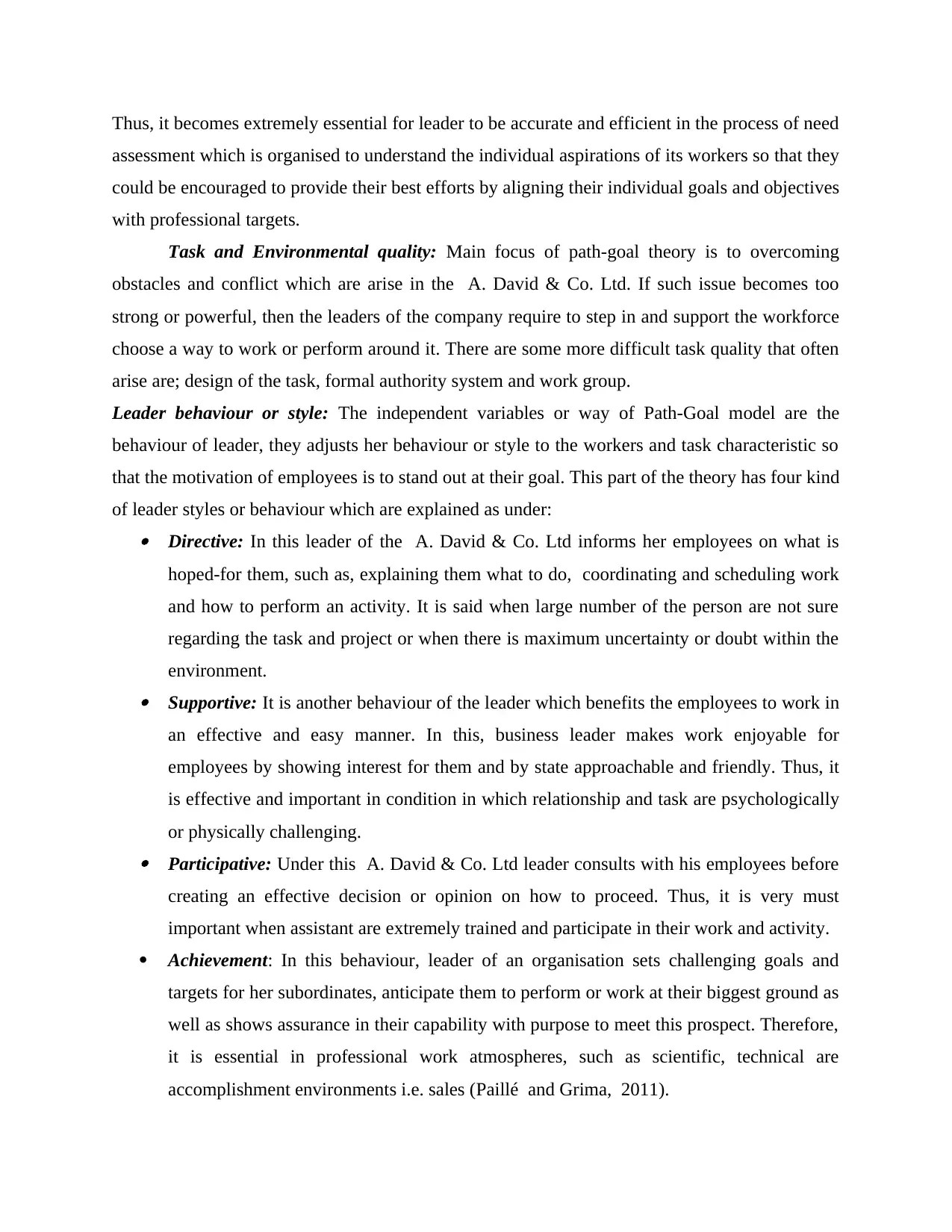
Thus, it becomes extremely essential for leader to be accurate and efficient in the process of need
assessment which is organised to understand the individual aspirations of its workers so that they
could be encouraged to provide their best efforts by aligning their individual goals and objectives
with professional targets.
Task and Environmental quality: Main focus of path-goal theory is to overcoming
obstacles and conflict which are arise in the A. David & Co. Ltd. If such issue becomes too
strong or powerful, then the leaders of the company require to step in and support the workforce
choose a way to work or perform around it. There are some more difficult task quality that often
arise are; design of the task, formal authority system and work group.
Leader behaviour or style: The independent variables or way of Path-Goal model are the
behaviour of leader, they adjusts her behaviour or style to the workers and task characteristic so
that the motivation of employees is to stand out at their goal. This part of the theory has four kind
of leader styles or behaviour which are explained as under: Directive: In this leader of the A. David & Co. Ltd informs her employees on what is
hoped-for them, such as, explaining them what to do, coordinating and scheduling work
and how to perform an activity. It is said when large number of the person are not sure
regarding the task and project or when there is maximum uncertainty or doubt within the
environment. Supportive: It is another behaviour of the leader which benefits the employees to work in
an effective and easy manner. In this, business leader makes work enjoyable for
employees by showing interest for them and by state approachable and friendly. Thus, it
is effective and important in condition in which relationship and task are psychologically
or physically challenging. Participative: Under this A. David & Co. Ltd leader consults with his employees before
creating an effective decision or opinion on how to proceed. Thus, it is very must
important when assistant are extremely trained and participate in their work and activity.
Achievement: In this behaviour, leader of an organisation sets challenging goals and
targets for her subordinates, anticipate them to perform or work at their biggest ground as
well as shows assurance in their capability with purpose to meet this prospect. Therefore,
it is essential in professional work atmospheres, such as scientific, technical are
accomplishment environments i.e. sales (Paillé and Grima, 2011).
assessment which is organised to understand the individual aspirations of its workers so that they
could be encouraged to provide their best efforts by aligning their individual goals and objectives
with professional targets.
Task and Environmental quality: Main focus of path-goal theory is to overcoming
obstacles and conflict which are arise in the A. David & Co. Ltd. If such issue becomes too
strong or powerful, then the leaders of the company require to step in and support the workforce
choose a way to work or perform around it. There are some more difficult task quality that often
arise are; design of the task, formal authority system and work group.
Leader behaviour or style: The independent variables or way of Path-Goal model are the
behaviour of leader, they adjusts her behaviour or style to the workers and task characteristic so
that the motivation of employees is to stand out at their goal. This part of the theory has four kind
of leader styles or behaviour which are explained as under: Directive: In this leader of the A. David & Co. Ltd informs her employees on what is
hoped-for them, such as, explaining them what to do, coordinating and scheduling work
and how to perform an activity. It is said when large number of the person are not sure
regarding the task and project or when there is maximum uncertainty or doubt within the
environment. Supportive: It is another behaviour of the leader which benefits the employees to work in
an effective and easy manner. In this, business leader makes work enjoyable for
employees by showing interest for them and by state approachable and friendly. Thus, it
is effective and important in condition in which relationship and task are psychologically
or physically challenging. Participative: Under this A. David & Co. Ltd leader consults with his employees before
creating an effective decision or opinion on how to proceed. Thus, it is very must
important when assistant are extremely trained and participate in their work and activity.
Achievement: In this behaviour, leader of an organisation sets challenging goals and
targets for her subordinates, anticipate them to perform or work at their biggest ground as
well as shows assurance in their capability with purpose to meet this prospect. Therefore,
it is essential in professional work atmospheres, such as scientific, technical are
accomplishment environments i.e. sales (Paillé and Grima, 2011).
⊘ This is a preview!⊘
Do you want full access?
Subscribe today to unlock all pages.

Trusted by 1+ million students worldwide
1 out of 15
Related Documents
Your All-in-One AI-Powered Toolkit for Academic Success.
+13062052269
info@desklib.com
Available 24*7 on WhatsApp / Email
![[object Object]](/_next/static/media/star-bottom.7253800d.svg)
Unlock your academic potential
Copyright © 2020–2025 A2Z Services. All Rights Reserved. Developed and managed by ZUCOL.





